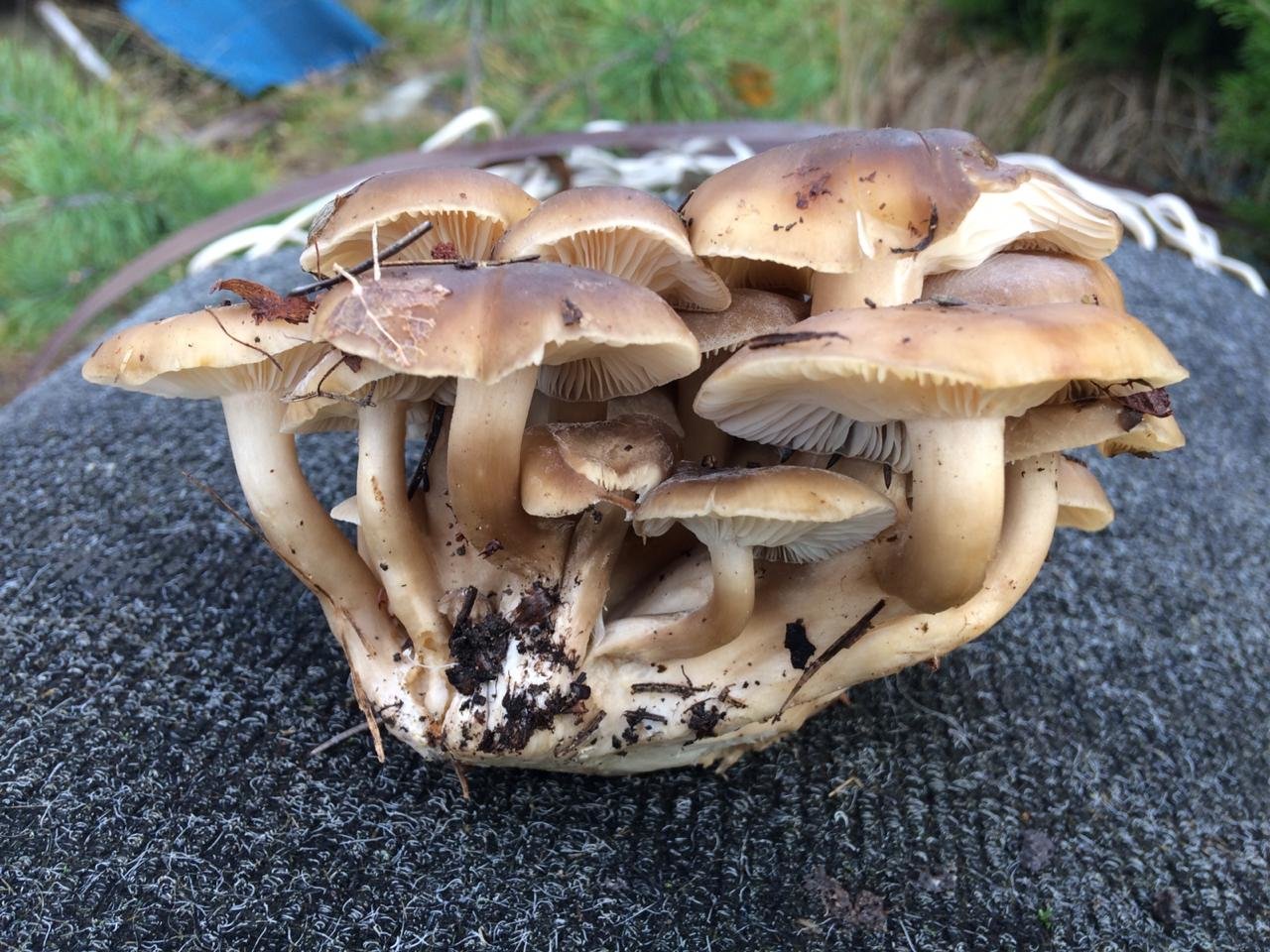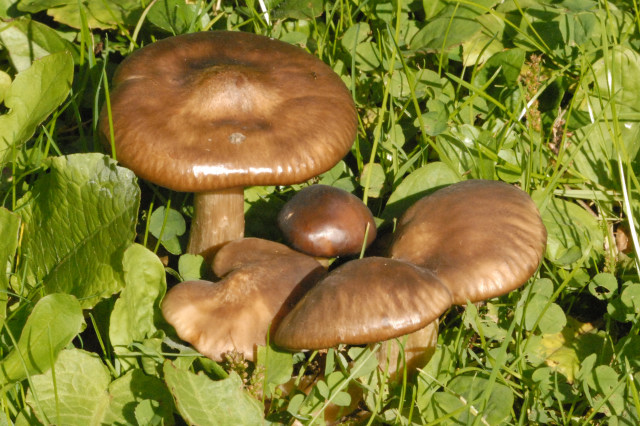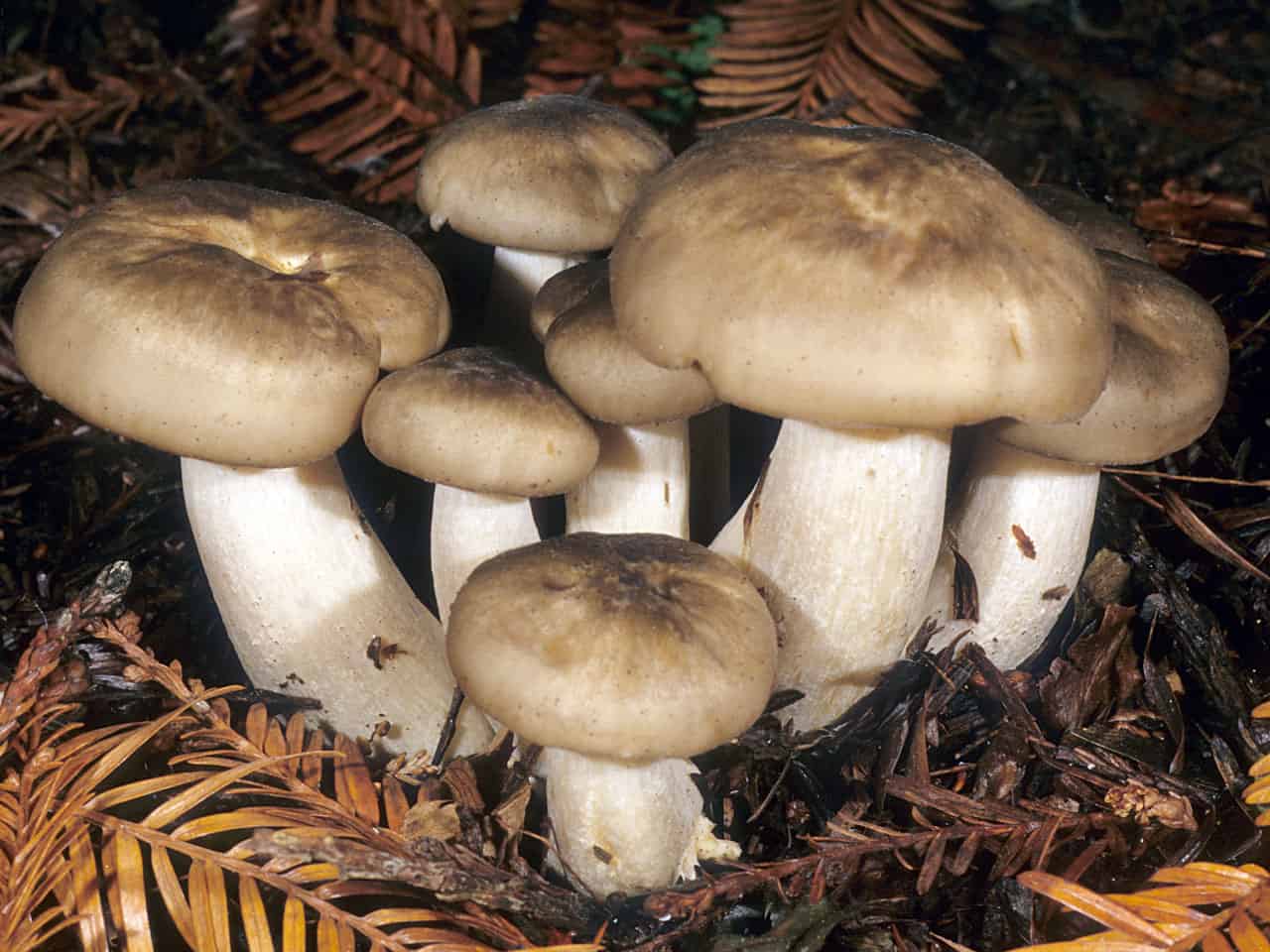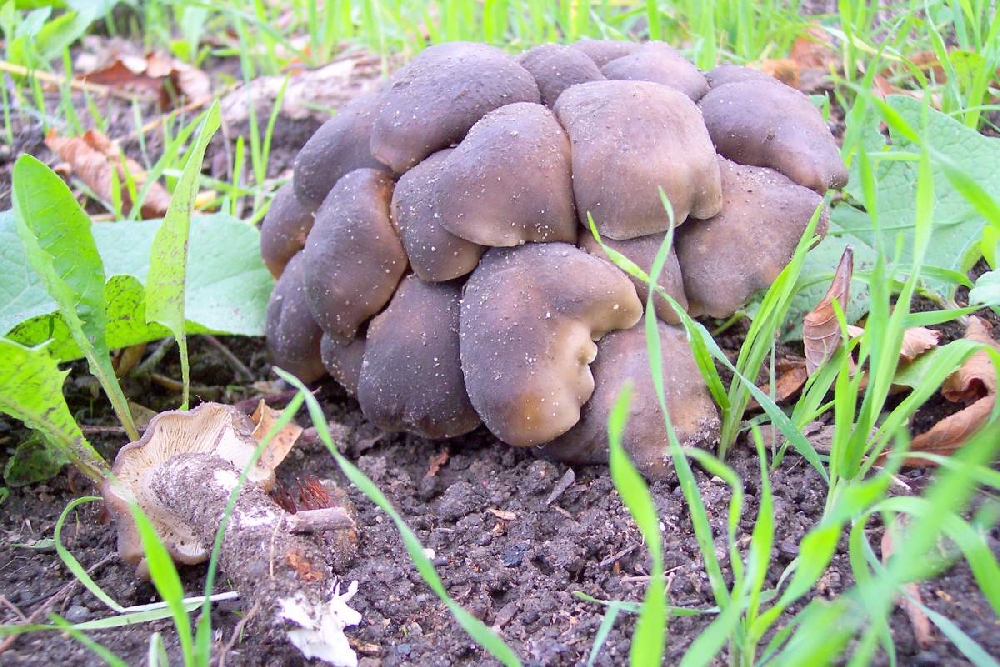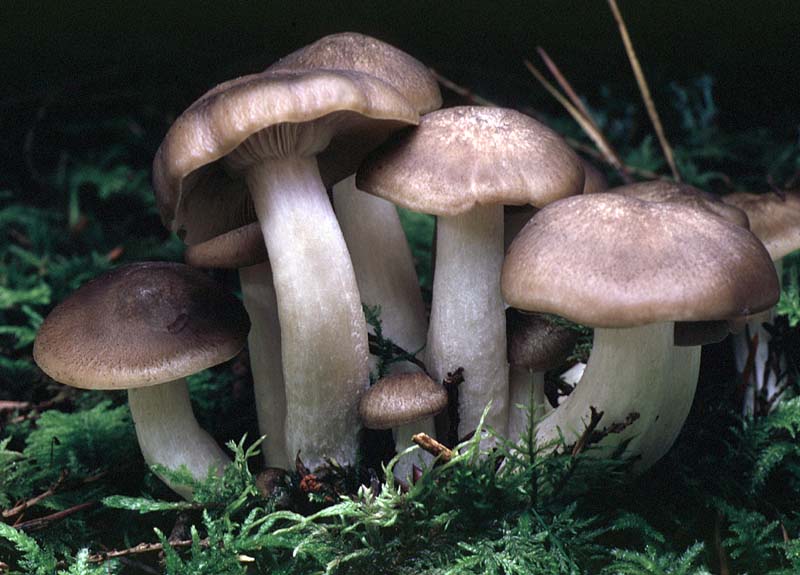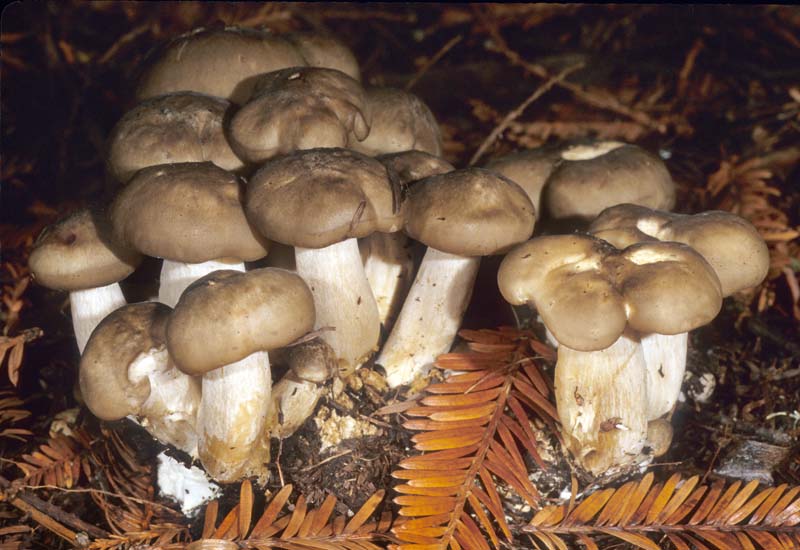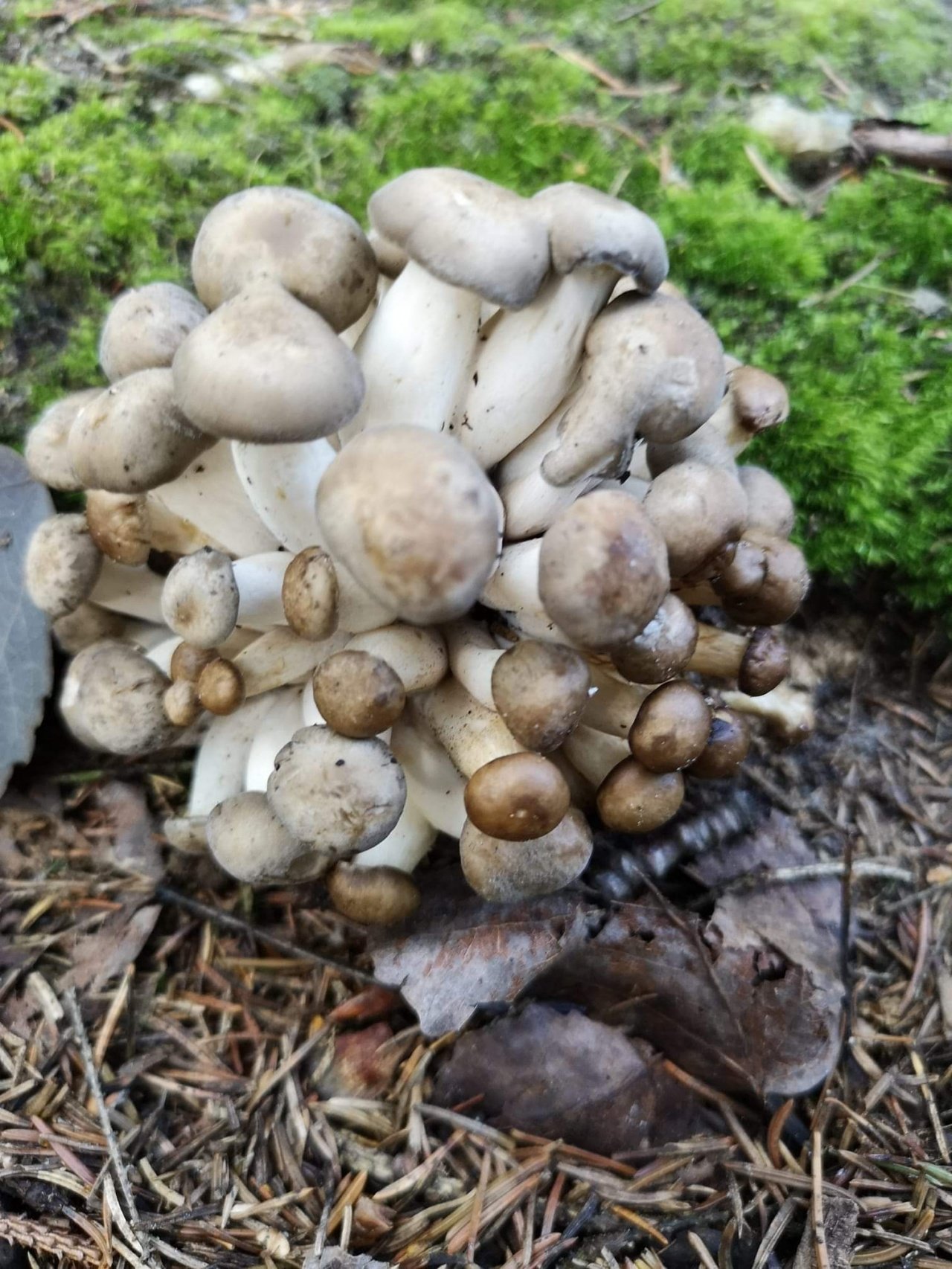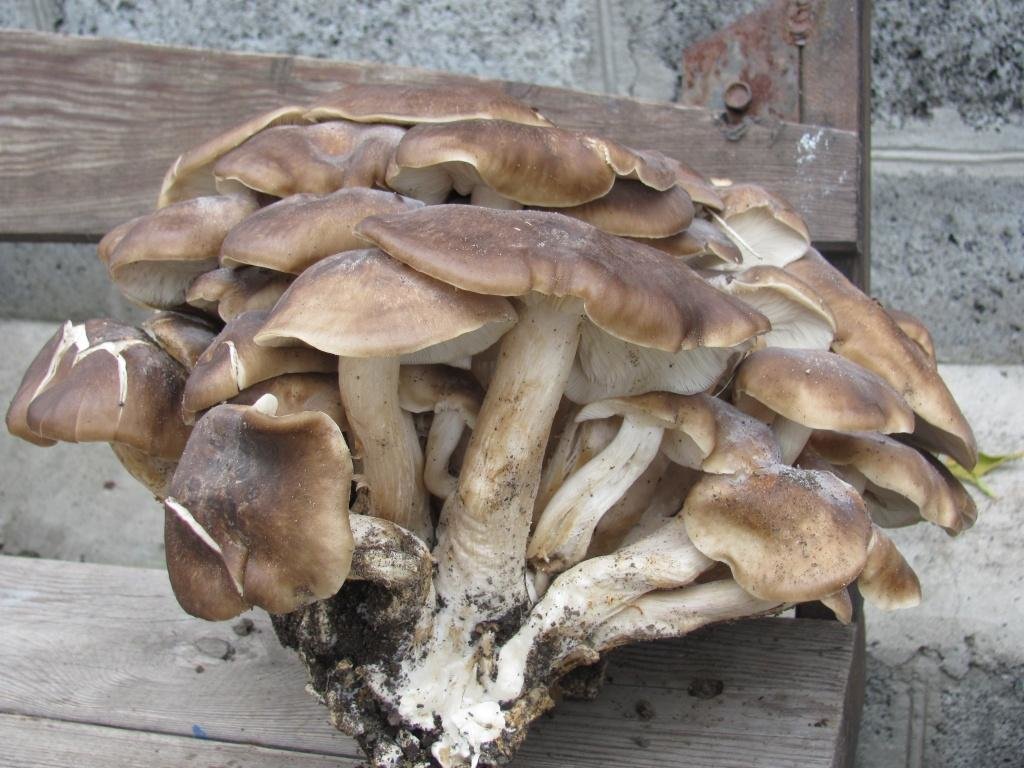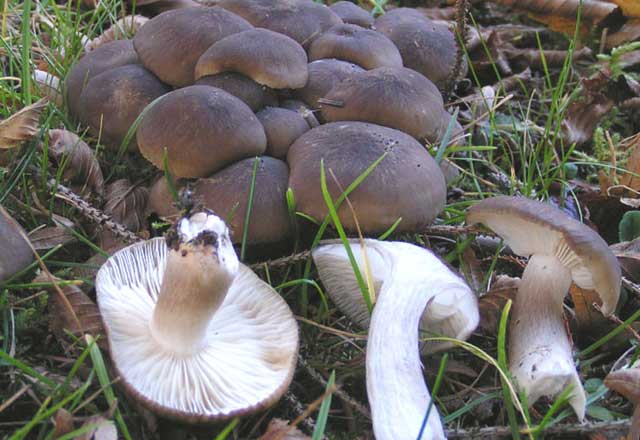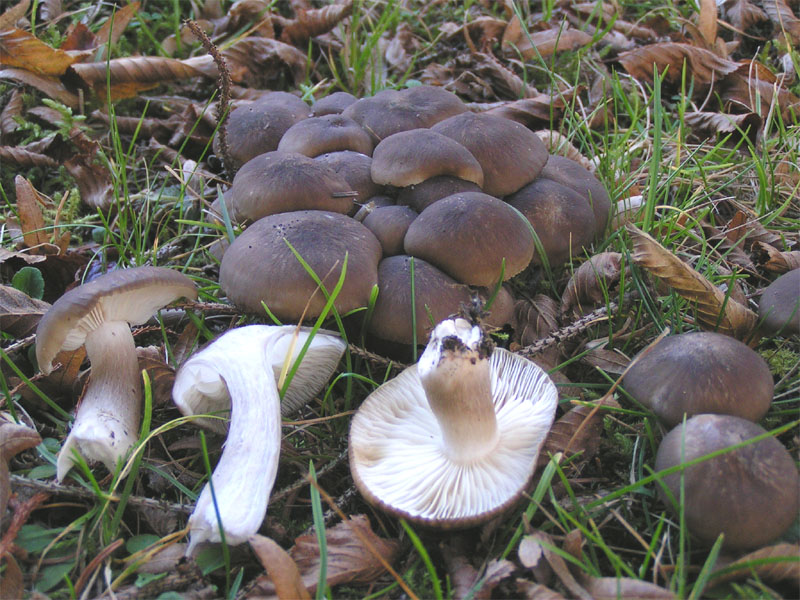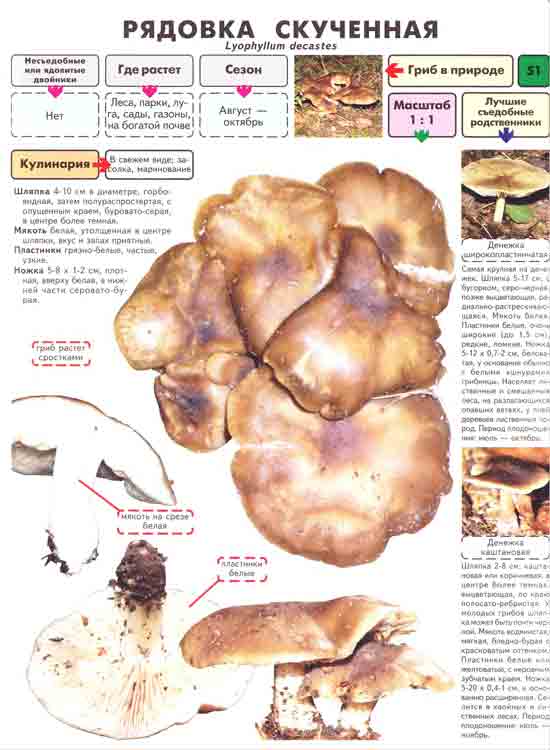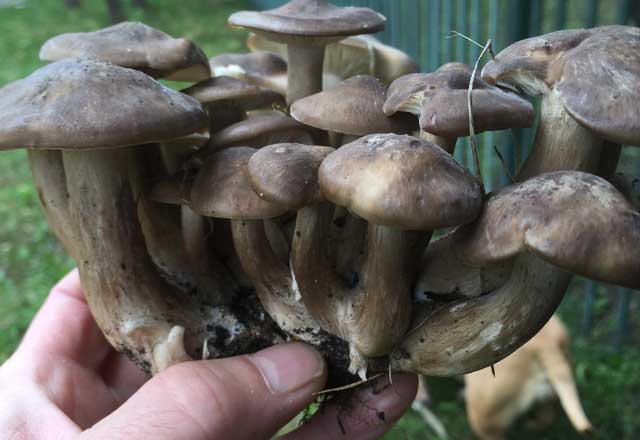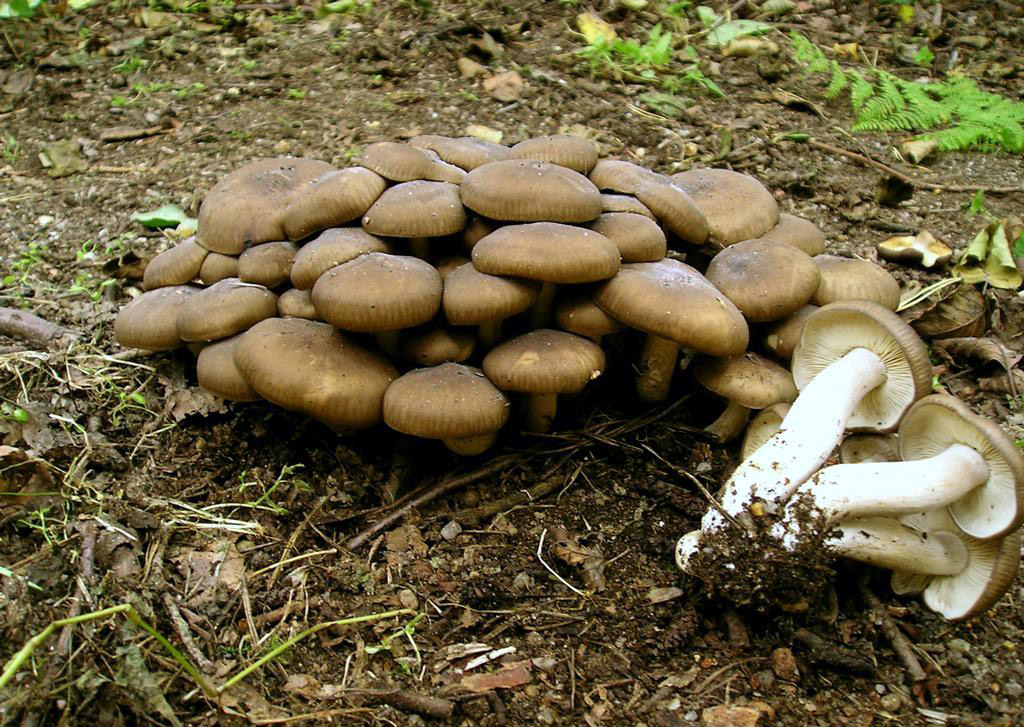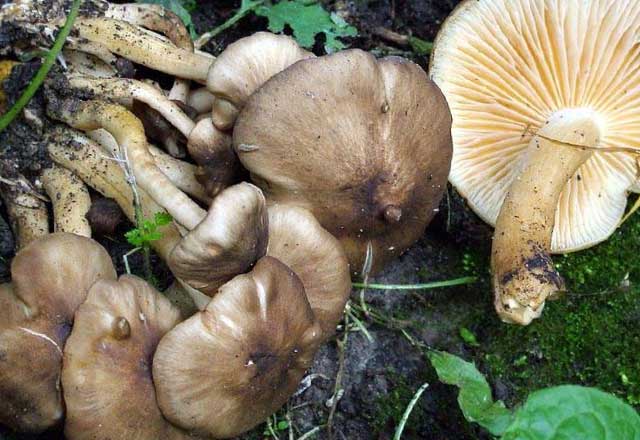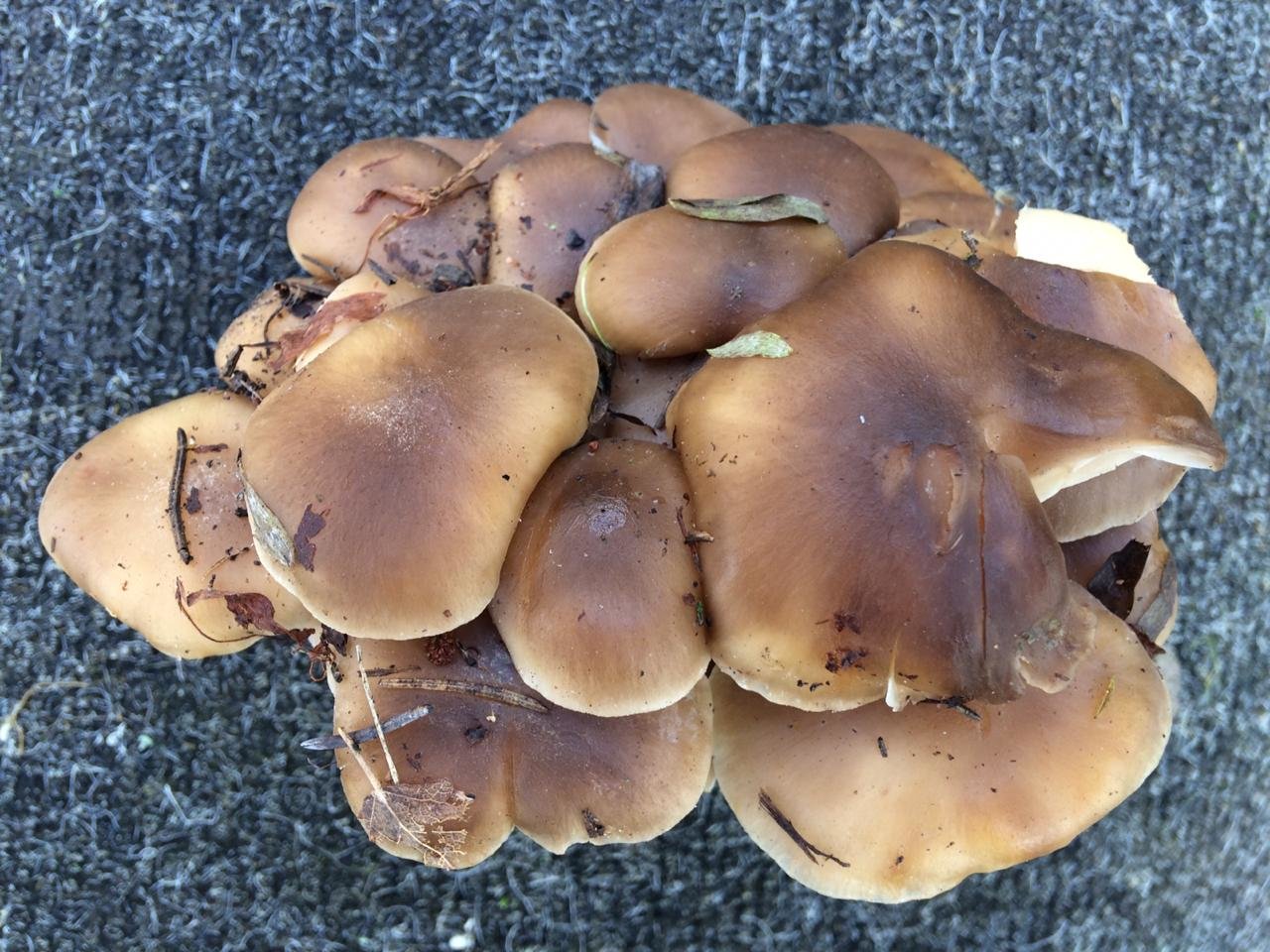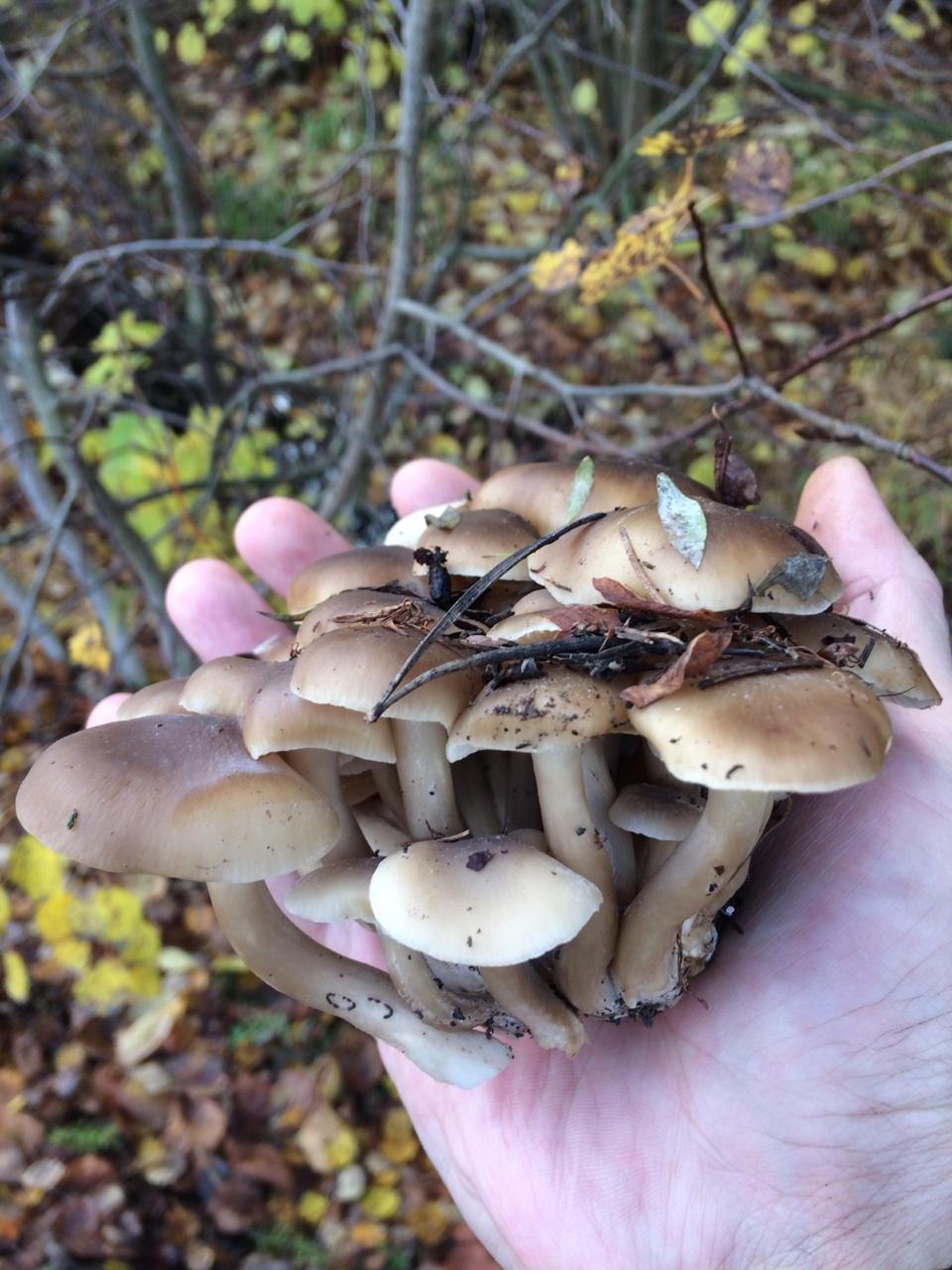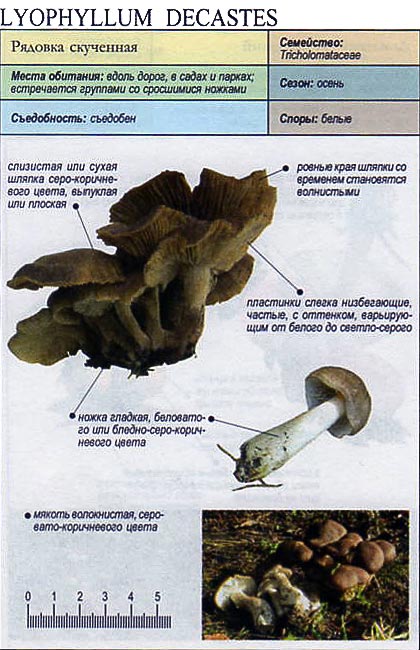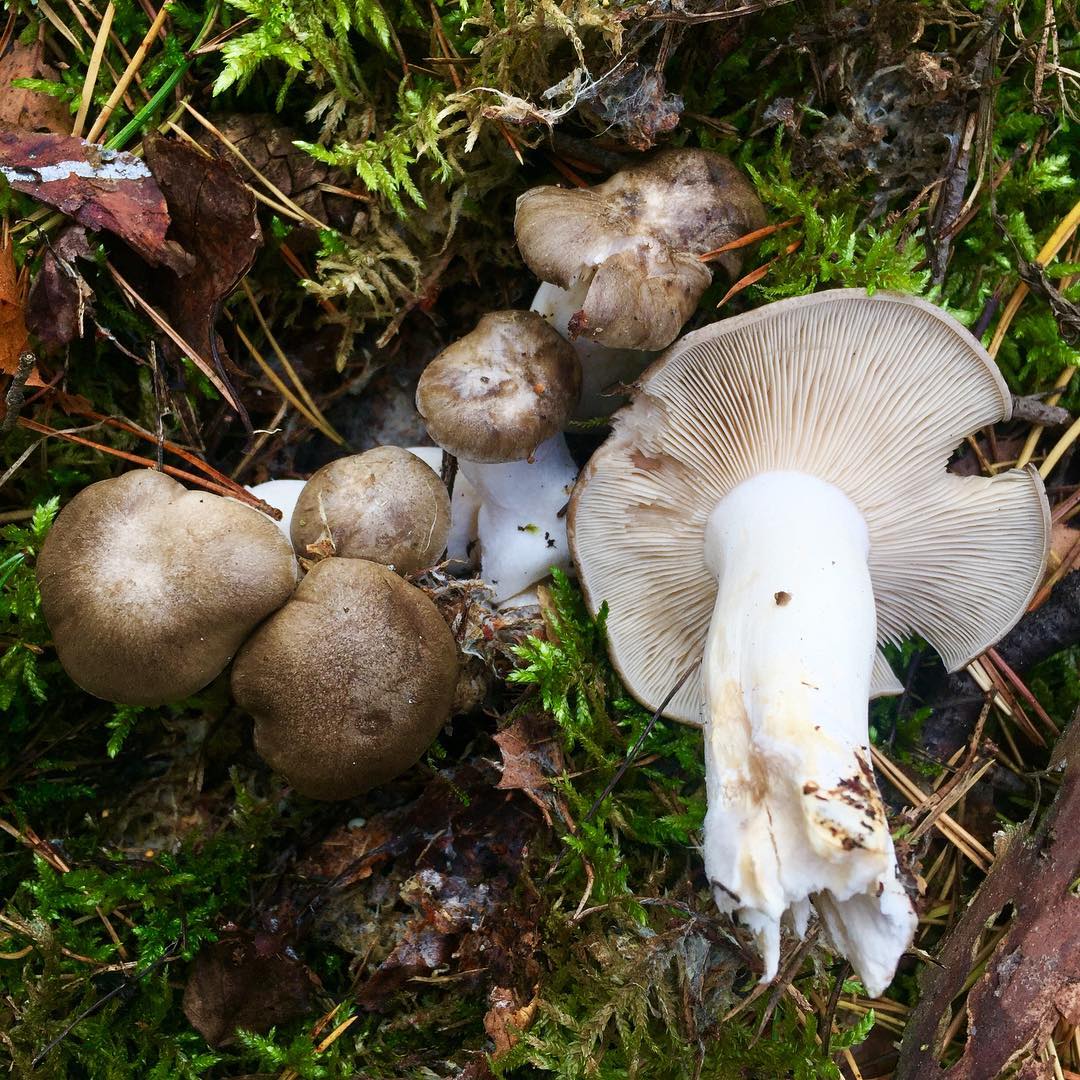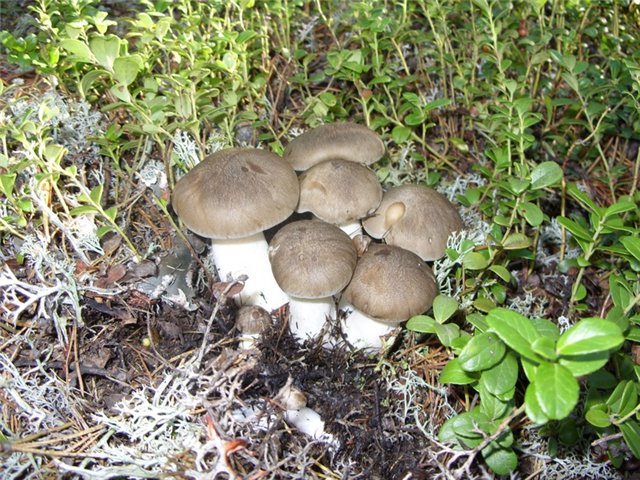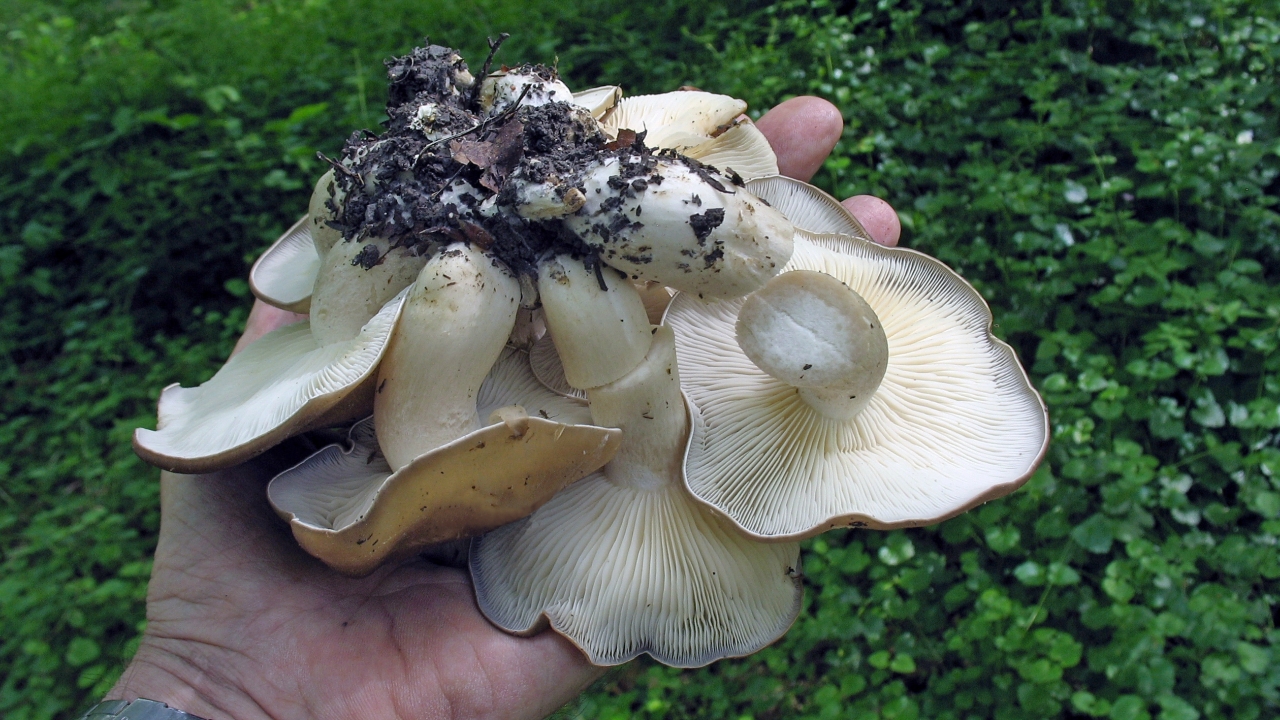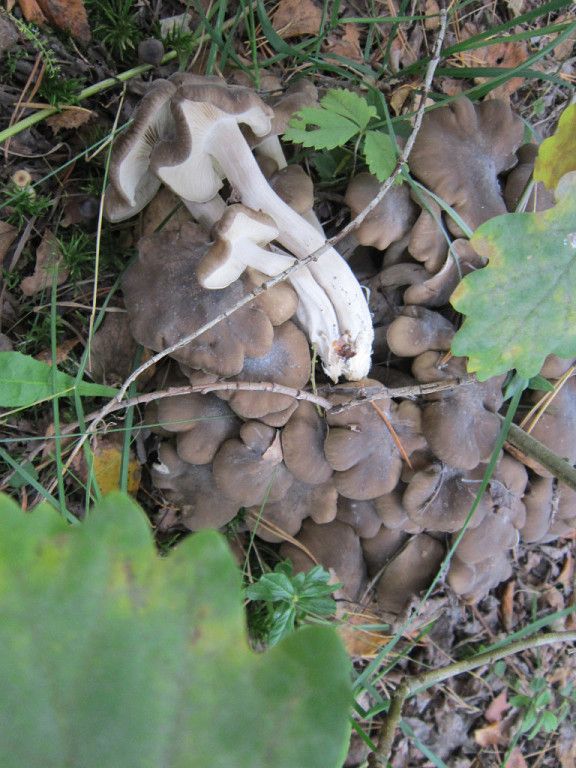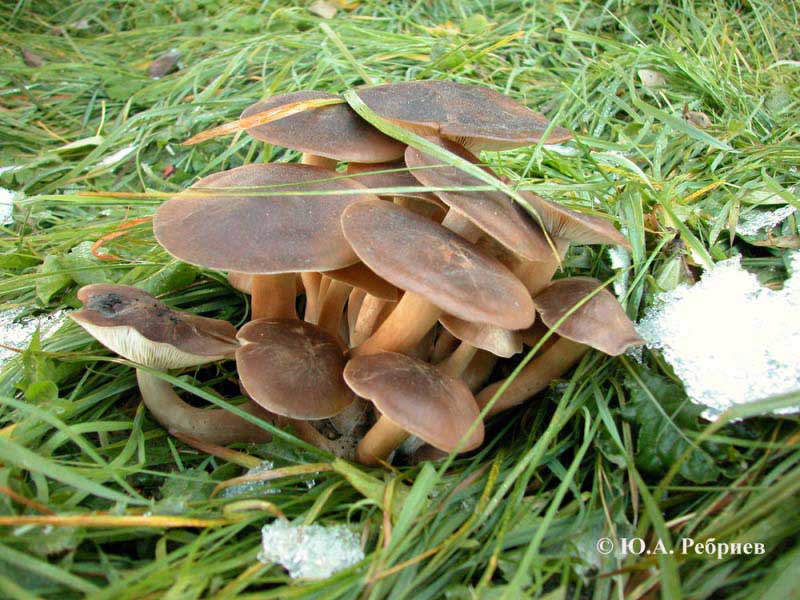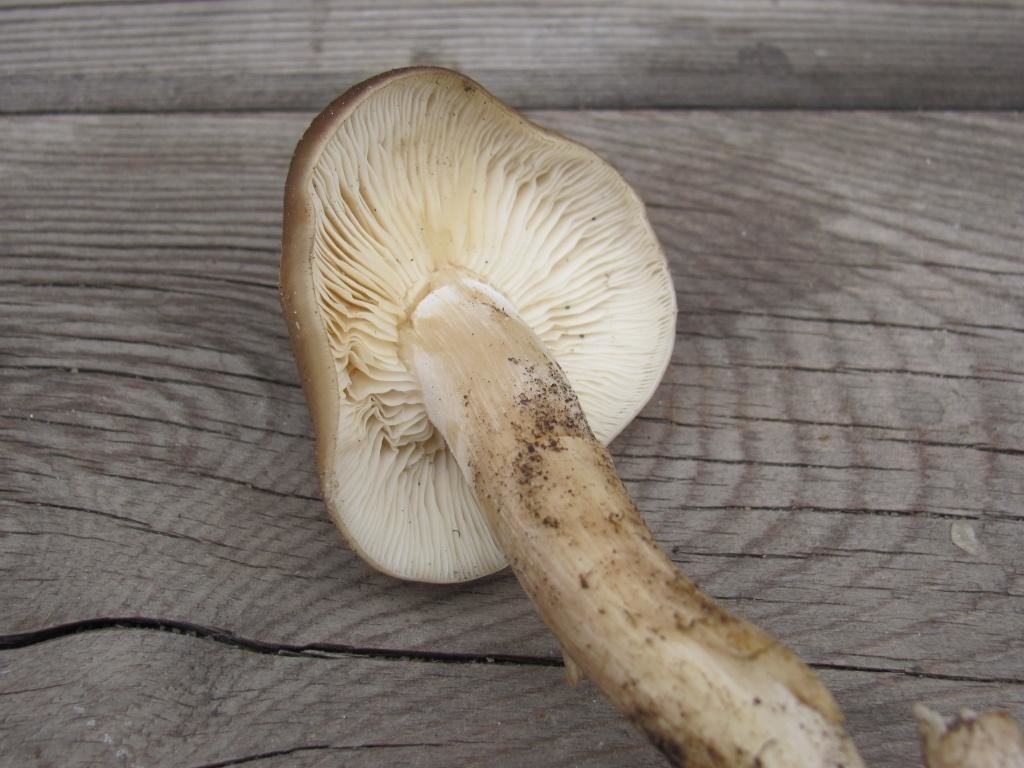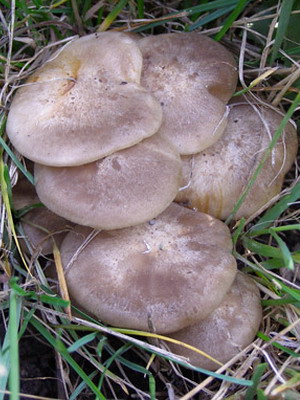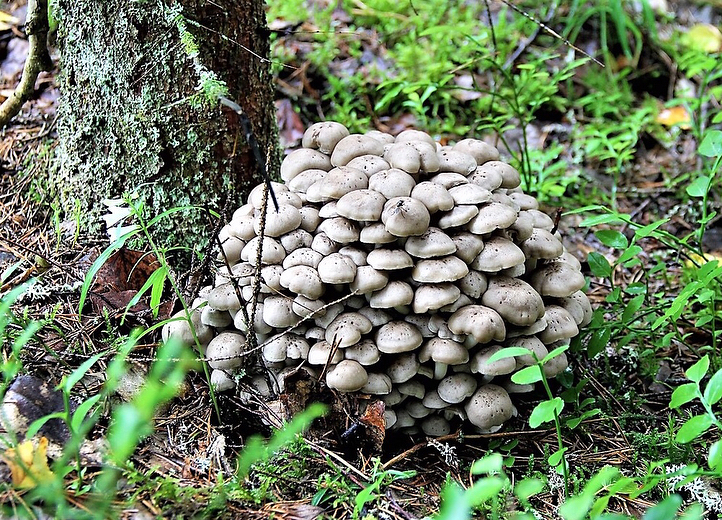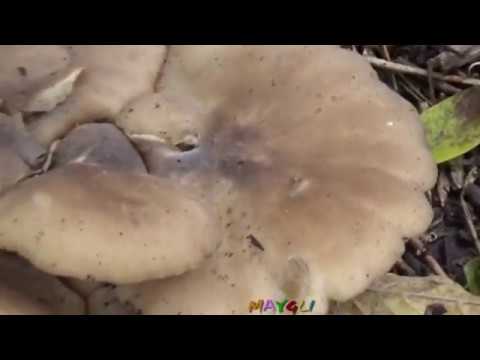Row crowded
| Group: | Lamellar |
|---|---|
| Plates: | White |
| Colour: | Brownish grayish |
| Info: | The edges of the hat are folded up |
| Department: | Basidiomycota (Basidiomycetes) |
|---|---|
| Subdivision: | Agaricomycotina (Agaricomycetes) |
| Class: | Agaricomycetes (Agaricomycetes) |
| Subclass: | Agaricomycetidae |
| Order: | Agaricales (Agaric or Lamellar) |
| Family: | Lyophyllaceae (Lyophilic) |
| Genus: | Lyophyllum (Lyophyllum) |
| View: | Lyophyllum decastes (Crowded row) |
It belongs to edible mushrooms of the 4th category (edible and conditionally edible specimens of little value in nutritional, culinary and gustatory terms, inferior in these indicators to mushrooms from the first, second and even third categories).
Description
The group row differs, as the name implies, by a special crowding of fruit chalk. They grow in large clusters, and this association contains mushrooms of various sizes, shapes and degrees of maturity.
Hat
In small rows, they are semicircular, with age they become almost flat. They are medium in size - about 7 - 10 cm maximum in diameter.
In mature specimens, the edges of the cap curl upward and are often cracked. The surface of the caps is smooth, their color is brownish-grayish. There is often noticeable sticky earth on it.
Leg
Not long and relatively thin (on average 10 cm and 1 cm, respectively). It has a cylindrical shape, there is a thickening in the lower part.
Often, the legs of these mushrooms are deformed, twisted and grow together with the legs of other fruit chalk growing nearby. The legs grow together at their base. The color of the legs can vary from white to brown. The surface of the legs is smooth.
Spore-bearing layer
Lamellar. Plates are often located, white. There are specimens with both free and with plates adhered to the stem.
Distribution and collection
The group ryadovka is widespread throughout the temperate climate. It usually grows in parks, along roads, in gardens, in general, wherever there is grass. It can grow on the edges of forests. It does not form mycorrhiza with any trees, as it is a saprophyte and takes nutrients from the soil and dead grass and leaves.
Similar species
The group ryadovka has both edible and conditionally edible, and even poisonous twins. Therefore, the utmost care is required when collecting such mushrooms.
Edible mushrooms, similar to the group row:
Gipsizigus chess (buna shimeji)
Grows in East Asia, artificially grown in Europe and America. Has a nut flavor. There are 2 varieties - white and brown.
Has a yellowish color. On the cap, mature mushrooms have a tubercle, and young ones are distinguished by a conical-shaped cap. Quite often completely wormy.
Conditionally edible counterparts of the crowded row:
It differs from the crowded row in larger sizes and thicker legs. When cooked, it gives off the smell of rose oil.
A darker color, the edges of the cap turn upward with age.
Collibia crowded
In contrast to the crowded row, it has smaller fruiting bodies with a reddish color.
Poisonous mushrooms, similar to group rowing:
Mushrooms are lighter than crowded ryadovka.
There is no information about cases of acute poisoning by a row of accreted information, however, some sources justify its toxicity by the accumulation of toxins in it, presumably causing cancer and mutations in DNA. Moreover, it is believed that these toxins are not destroyed even when the mushroom is boiled.
Edibility
Crowded rows can be eaten immediately after a 20-minute boil, or they can be salted or pickled. To weld the rows, you only need salt and water. If marinating is planned further, then you can pour a little vinegar into the water. Rows are not stored raw, as they are often worms and quickly deteriorate.
Interesting Facts
A few little-known and entertaining facts:
- In America, the crowded ryadovka is called “Fried Chicken Mushroom” (literally, “mushroom - fried chicken”), since when finished, the ryadovka tastes like chicken meat.
- Rows can be grown at home. The cultivation technology is about the same as for champignons.
- Powder from dried rows is used in cosmetology for the treatment of increased oily skin.
- Since overripe rows are very wormy, it is better to collect only young mushrooms.
Description of the crowded row
Due to their high protein content, mushrooms are a substitute for meat. The crowded row (Lyofillum) replaces chicken not only in nutritional value, but also in taste.
Description of the crowded row
Description of the mushroom
Lyophillums grow on the ground in deciduous or mixed forests. The species begins to bear fruit at the end of August, the last representatives are found in the forest in November.
- the diameter of the cap is 4-12 cm, the color is dirty white, gray-brown, brightens with age;
- the shape of the cap is hemispherical at first, the edges are wrapped, in adult Mushrooms it is convex-outstretched, the edges are wavy or lobed;
- the cap is fleshy, but brittle;
- the plates are frequent, yellowish, when pressed, they become darker;
- leg 3-9 cm high, in girth 0.5-2.5 cm, cylindrical, sometimes slightly swollen or thickened downwards;
- grows in groups, the legs grow together strongly at the base.
The mushroom grows in a large family, but sometimes there are lonely representatives. Mushrooms of different ages with different shapes and shades of caps are found in the group. It is recommended to eat young mushrooms.
According to the description, the crowded row is easy to confuse with a poisonous row that has grown together. The species has a lighter color, a white leg, which becomes hollow with age. Previously, fused lyophyllum was edible, in recent years, after a detailed study of its components, it was ranked as poisonous. During cooking, toxic substances are not removed from the mycelium.
Mushrooms bear fruit from late August to November
The benefits of the mushroom
If properly collected and cooked, mushrooms have the following effects on the body:
- antibacterial;
- antiviral;
- anti-inflammatory;
- anti-radical (prevents excessive oxidation in the body);
- immunostimulating (increases the general resistance of the body to diseases);
- hepatotoxic (cleanses the liver);
- hypoglycemic (lowers blood glucose).
Also, the B vitamins in the composition of the mushroom promote brain activity, increase efficiency. The use of the product helps to strengthen blood vessels.
Contraindications to use
The crowded row is prohibited for use in the following cases:
- age up to 12 years;
- pregnancy and lactation;
- diseases of the gastrointestinal tract;
- renal failure;
- liver failure.
In the presence of contraindications, poisoning occurs. The main signs are headache, dizziness, nausea, vomiting, loose stools. If symptoms develop, the stomach is washed out to a poisoned person. Then he must take special drugs to remove toxins and normalize the composition of the microflora.
You can't eat mushrooms that grow near working factories, busy highways. Fruiting bodies quickly collect toxins.
Application
The crowded row has found application in cooking, traditional and folk medicine. She is the object of scientific research.
In cooking
Lyophillum is allowed to be eaten only after boiling. The species is classified as conditionally edible. After 10-15 minutes. boiling in clean water, toxic substances are removed from the mycelium.
Boiled mushroom tastes like chicken. It is used with vegetables, added to soups, salted and pickled. Vegetarians use the product to replenish protein in the body.
The crowded row has found application in cooking, traditional and folk medicine
In medicine
The chemical composition and useful properties have led to the widespread use of lyophillums in medicine. Antibacterial and antiviral drugs are obtained from the fruit bodies. Also, mushrooms are included in the diet of patients with diabetes, since they normalize blood sugar levels.
On the basis of lyophillums, drugs are made for atherosclerosis. Some components of the mycelium are capable of stopping the formation of cholesterol plaques.
The anticancer activity of fungi is being studied. Some drugs for sarcoma, breast and uterine cancer contain components of the mycelium.
Soap row (Tricholoma saponaceum)
Systematics:
- Department: Basidiomycota (Basidiomycetes)
- Subdivision: Agaricomycotina
- Class: Agaricomycetes (Agaricomycetes)
- Subclass: Agaricomycetidae
- Order: Agaricales (Agaric or Lamellar)
- Family: Tricholomataceae (Tricholomaceae or Ordinary)
- Genus: Tricholoma (Tricholoma or Ryadovka)
- Species: Tricholoma saponaceum (Soap row)
Synonyms:
- Agaricus saponaceus;
- Gyrophila saponacea;
- Tricholoma moserianum.

Mushroom Ryadovka soap (Latin Tricholoma saponaceum) belongs to the genus of mushrooms of the Ryadovkov family. Basically, the family of these mushrooms grows in rows, for which it got its name.
Soapy ryadovka is named for the rather unpleasant odor of laundry soap emitted.
How to distinguish from false and poisonous mushrooms
Among other features of this variety, it is worth highlighting the almost complete absence of its poisonous counterparts. This undoubted advantage eliminates even the slightest risk of confusing an edible mushroom with a toxic twin. But it is quite possible to collect other members of the family instead of a crowded row, another thing is that such mistakes do not lead to any serious consequences.
Accreted row
Quite often, a crowded variety is confused with an accrete one, which also tends to grow in whole colonies. However, these species also have a significant difference, which consists in the uniform snow-white color of the fruits of the intergrown row and the smaller size of its cap, which does not go beyond 3-8 cm.

As it ages, its tough pulp becomes loose and loses its former aroma with its inherent delicate woody notes. Towards the end of the life cycle, the pulp of the variety begins to exude an unpleasant odor at all, for which the mushroom is often mistaken for inedible and even poisonous.
Smoky gray talker
Even more similar to the crowded variety is smoky lyophyllum, which is popularly called a smoky gray talker. But this row is much larger and a little darker. In addition, its characteristic feature is a delicate fruity-floral aroma, which is unusual for mushrooms.

The leg of this species, which resembles a mace, is also denser. Such mushrooms grow not only in mixed forests and spruce forests, but also in gardens, in personal plots. And some summer residents manage to grow them even in their own gardens.
Lyophillum armored
Even more heaped are accustomed to growing armored rows, also in many ways resembling a crowded look, with the exception of the smaller size of the cap and its thinned edge. In some way, these fungi also resemble wild oyster mushroom, having the same dark noble color.
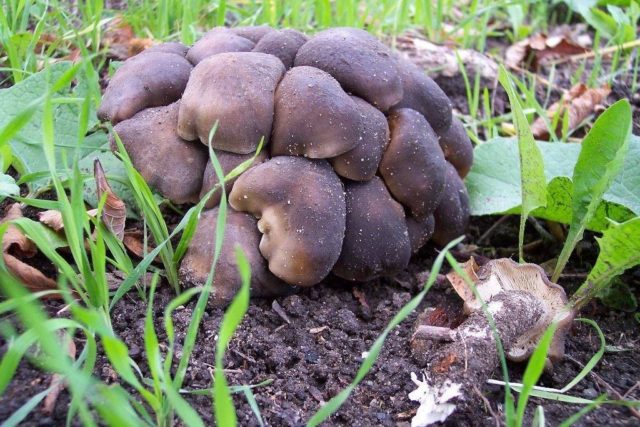
This variety is conditionally edible, being suitable for consumption after using certain processing methods.
Collibia crowded
Mushrooms also grow in colonies, but look less like a row, with a small glossy cap up to 4 cm in diameter with a characteristic darkening in the center and red inwardly curled margins. The key feature of colibia is that in the heat it begins to wrinkle and fade in the sun.

As for the palatability, the pulp, which is too dense, watery and neutral in its organoleptic properties, was the main reason why the variety was assigned to the IV category.
Crowded row (Lyophyllum decastes)
- Other names for the mushroom:
- Lyophillum crowded
- Group rowing
Synonyms:
Crowded lyophyllum is very widespread. Until recently, it was believed that the main "fiefdom" of this mushroom is parks, squares, roadsides, slopes, edges and similar open and semi-open places. At the same time, there was a separate species, Lyophyllum fumosum (L.smoky gray), associated with forests, especially conifers, some sources even described it as a mycorrhizal forming agent with pine or spruce, outwardly very similar to L.decastes and L.shimeji. Recent molecular studies have shown that no such separate species exists, and all finds classified as L. fumosum are either L.decastes (more commonly) or L. shimeji (less commonly pine forests). Thus, today (2018), the species L.fumosum has been abolished, and is considered a synonym for L.decastes, significantly expanding the habitat of the latter, almost to “anywhere”. Well, L.shimeji, as it turned out, grows not only in Japan and the Far East, but is widespread throughout the boreal zone from Scandinavia to Japan, and, in some places, is found in pine forests of the temperate climatic zone. It differs from L.decastes only in larger fruit bodies with thicker legs, growth in small aggregates or separately, binding to dry pine forests, and at the molecular level.
Description
Hat:
The crowded row has a large cap, 4-10 cm in diameter, in youth it is hemispherical, cushion-shaped, as the mushroom matures, it opens to half-spread, less often spread, often losing the geometric correctness of the outlines (the edge turns upward, becomes wavy, cracks, etc.) ). Caps of different sizes and shapes can usually be found in one splicing. The color is gray-brown, the surface is smooth, often with adhered earth. The flesh of the cap is thick, white, dense, elastic, with a weak "ordinary" smell.
Plates:
Relatively frequent, white, poorly adherent or loose.
Spore powder:
White.
Leg:
Thickness 0.5-1.5 cm, height 5-10 cm, cylindrical, often with a thickened lower part, often twisted, deformed, fused with the base with other legs. The color is from white to brownish (especially in the lower part), the surface is smooth, the pulp is fibrous, very strong.
Spreading
Late mushroom; occurs from late August to late October in forests of various types, preferring specific areas such as forest roads, thinned edges; sometimes it comes across in parks, in meadows, in forbs. In most cases, it bears fruit in large aggregates.
Similar species
The fused row (Lyophyllum connatum) has a light color.
The crowded row can be confused with some edible and inedible species of lamellar mushrooms, growing concretions. Among them are mentioned such species of the family as Collybia acervata (a smaller mushroom with a reddish tinge of the cap and leg), and Hypsizygus tessulatus, which causes brown wood rot, as well as some species of honey agaric from the genus Armillariella and meadow honey (Marasmius oreades).
Edibility
The crowded row is considered a low-quality edible mushroom; the texture of the pulp gives a comprehensive answer why.
Refinements to the description: Sergey
Cooking
In order to properly prepare crowded rows, you should first boil them.
- rows - 1 kg;
- salt - 1 tablespoon;
- water - 1 liter;
- citric acid - a pinch;
- black peppercorns - 6 pcs.;
- bay leaf - 1 pc .;
- dry cloves - 2 buds.
- Clean the fruit bodies of sand and dirt.
- Remove damaged areas, discard rotten or wormy mushrooms. If the fruiting body is especially dirty, then you need to carefully peel off the skin with a knife.
- Rinse the fruit under running water.
- Pour cold water into a saucepan, add salt, citric acid, bring to a boil.
- Place the fruits in a bowl and cook for 20 minutes over medium heat.
- Add the spices 10 minutes after starting cooking. Boil for another 7-8 minutes.
- Throw the mushrooms in a colander, dry.
Lyophillum shimeji
Hon-shimeji
Until recently, it was believed that Shimeji Lyophyllum (Lyophyllum shimeji) is distributed only in a limited area covering the pine forests of Japan and parts of the Far East. At the same time, there was a separate species, Lyophyllum fumosum (L.smoky gray), associated with forests, especially conifers, some sources even described it as a mycorrhizal forming agent with pine or spruce, outwardly very similar to L.decastes and L.shimeji. Recent molecular studies have shown that no such separate species exists, and all finds classified as L. fumosum are either L.decastes (more commonly) or L. shimeji (Lyophillum simeji) (less commonly, in pine forests). Thus, today (2018), the species L.fumosum has been abolished, and is considered a synonym for L.decastes, significantly expanding the habitat of the latter, almost to “anywhere”. Well, L.shimeji, as it turned out, grows not only in Japan and the Far East, but is widespread throughout the boreal zone from Scandinavia to Japan, and, in some places, is found in pine forests of the temperate climatic zone. It differs from L.decastes only in larger fruit bodies with thicker legs, growth in small aggregates or separately, binding to dry pine forests, and at the molecular level.
Description
Hat: 4 - 7 centimeters. In youth, it is convex, with a pronounced curved edge. With age it evens out, becomes slightly convex or practically spread, in the center of the cap, a pronounced wide, low tubercle is almost always preserved. The skin of the cap is slightly matte, smooth. The color range - in gray and brownish tones, from light grayish-brown to dirty gray, can acquire yellowish-gray shades. On the cap, dark hygrophane spots and radial stripes are often clearly distinguishable; sometimes, a small hygrophane pattern in the form of a "mesh" can be present.
Plates: frequent, narrow. Loose or slightly adherent. In young specimens, white, later darken to beige or grayish.
Leg: 3 - 5 centimeters in height and up to one and a half centimeters in diameter, cylindrical. White or grayish. The surface is smooth, can be silky or fibrous to the touch. In the growths formed by mushrooms, the legs are firmly attached to each other.
Ring, bedspread, volva: none.
Flesh: firm, white, slightly grayish in the stem, firm. Does not change color at cut and break.
Smell and taste: pleasant, slightly nutty taste.
Spore powder: white. Spores: round to broadly ellipsoid. Smooth, colorless, hyaline or with fine-grained intracellular content, weakly amyloid. With a large spread in size, 5.2 - 7.4 x 5.0 - 6.5 microns.
Season and distribution
Active fruiting occurs in August - September. Lyophyllum shimeji grows in small aggregates and groups, rarely singly. Distributed throughout Eurasia from the Japanese archipelago to Scandinavia.
Similar types and differences from them
Crowded lyophyllum (Lyophyllum decastes) also grows in aggregates, but these aggregates consist of a much larger amount of fruit chalk. Prefers deciduous forests. The fruiting period is from July to October. Lyophyllum elm (Oyster mushroom, Hypsizygus ulmarius) is also considered very similar in appearance due to the presence of hygrophane rounded spots on the cap. In oyster mushrooms, fruiting bodies with a more elongated stem and the color of the cap are generally lighter than in Lyophillum simeji
However, these external differences are not so fundamental if we pay attention to the environment. Oyster mushroom does not grow on soil, it grows exclusively on dead wood of deciduous trees: on stumps and wood residues immersed in the soil
Other information about the mushroom
The specific name "Shimeji" comes from the Japanese name for the species Hon-shimeji or Hon-shimejitake. But in fact, in Japan under the name "Shimeji" one can find on sale not only Lyophyllum shimeji, but also, for example, another lyophillum actively cultivated there, elm.
Mushroom photo Lyophillum shimeji from questions in recognition:
Ecology and distribution
Saprophyte.It grows on soil in deciduous and mixed forests, preferring specific areas like the sides of forest roads and paths, woodlands, thinned edges; sometimes comes across in gardens and parks, in meadows, in hedges, in grasses. As a rule, bears fruit in large groups, sometimes growing together at the bases and sides of the legs; very rarely - singly. Not associated with certain trees. Widespread and common in the temperate zone of the Northern Hemisphere.
Season September — October (mass fruiting in the first half of September); finds possible in late August and November.
Growing at home and in the country
The methods of cultivating crowded rows are similar to the methods of growing mushrooms, but this process will still require certain skills. Features of the cultivation of lyophyllum:
- The room temperature should be 15 ° C.
- The most optimal time for breeding rows is May, but autumn is also quite suitable.
- In the summer cottage, the mushroom is grown in the beds, which should be covered with a film from the scorching sun and precipitation.
To grow rows in the country, you need to do the following:
- Mix the substrate with mycelium in a 1: 2 ratio, cover with foil to ensure high humidity.
- After 2-3 weeks, cover the culture with a 5 cm layer of moist soil.
- In a month, the first fruiting bodies will appear on the surface of the soil.
- After each harvest, it is necessary to make an additional layer of soil of half a centimeter.
- As soon as the temperature drops below 5 ° C, cover the ground with mycelium with a cloth, and lay a layer of leaves or straw at least 10 cm on top.
Evaluation of taste, medicinal properties, benefits and possible harm
The mushroom is classified as a species with high palatability. It is recommended to use young fruit bodies for food after boiling for 20 minutes, and then subject to any type of processing: pickle, cook fried, salt.
Useful properties of crowded lyophillum:
- enhances immunity;
- cleanses the liver;
- lowers blood glucose levels;
- anti-inflammatory and antiviral action;
- B vitamins improve brain activity, increase efficiency;
- strengthens the walls of blood vessels.
It is forbidden to use ryadovki for children under 12 years of age, pregnant and lactating women, people with diseases of the gastrointestinal tract during exacerbations, with renal and hepatic insufficiency.
Primary processing and cooking recipes
Before harvesting or frying crowded lyophillum, you should first clean the fruit bodies of debris, cut them into pieces, if necessary, and then boil the mushrooms in a large amount of slightly salted water. The cooking time should be 15–20 minutes. The mushrooms are thrown into a colander, the liquid is allowed to drain and the heat treatment is continued.
Cooking
In order to properly prepare crowded rows, you should first boil them.
- rows - 1 kg;
- salt - 1 tablespoon;
- water - 1 liter;
- citric acid - a pinch;
- black peppercorns - 6 pcs.;
- bay leaf - 1 pc .;
- dry cloves - 2 buds.
- Clean the fruit bodies of sand and dirt.
- Remove damaged areas, discard rotten or wormy mushrooms. If the fruiting body is especially dirty, then you need to carefully peel off the skin with a knife.
- Rinse the fruit under running water.
- Pour cold water into a saucepan, add salt, citric acid, bring to a boil.
- Place the fruits in a bowl and cook for 20 minutes over medium heat.
- Add the spices 10 minutes after starting cooking. Boil for another 7-8 minutes.
- Throw the mushrooms in a colander, dry.
Pickling
Fragrant, tasty, crispy rows are easy to pickle for the winter. This does not require expensive components.
Ingredients for 1 kg of mushrooms:
- vinegar 6% - 90 ml;
- sugar - 1.5 tbsp. l .;
- peppercorns - 5 pcs.;
- salt - 1 tbsp. l .;
- bay leaf - 2 pcs.;
- cloves - 4 pcs.
- Go through the fruits, leave only the most elastic for pickling. Cut large specimens, small ones - leave intact.
- Boil lyophillums in the traditional way with the addition of spices and salt, constantly skimming off the foam.
- Add vinegar, stir.
- Put the mushrooms in prepared, sterilized jars, fill with marinade. Roll up.
- Store canned food in a dark, cool place.
How to fry the rows deliciously?
This dish can harmoniously complement any side dish of vegetables, cereals, pasta, fried potatoes.
- rows - 1 kg;
- onion - 2 heads;
- vegetable oil - 50 ml;
- salt, black pepper to taste.
- Boil the mushrooms in the usual way in salted water. Throw in a colander, let the liquid drain.
- Heat sunflower oil in a frying pan, place the rows in it. Fry, stirring occasionally, for 10 minutes.
- Season with salt and pepper and cook for 2-3 minutes.
Salting

There are 2 ways to pickle mushrooms: hot and cold. With the first method, the rows will be ready in 7-10 days, and the second will provide a crispy, elastic structure of each mushroom.
- boiled rows - 3 kg;
- table salt -5 tbsp. l .;
- bay leaf - 4 pcs.;
- dill (umbrellas) - 5 pcs.
- Place the boiled fruit bodies in clean, dry jars with the caps down (the layer should be no more than 5–6 cm). Sprinkle each layer with salt and spices (by eye).
- Fill containers to the top. Place oppression on each of them.
- As soon as the fruiting bodies settle down, you can add a new layer of mushrooms.
- After 2-3 days, fill the contents of the jars with boiled cold water, close with nylon caps. Store in a cool, dark place.


